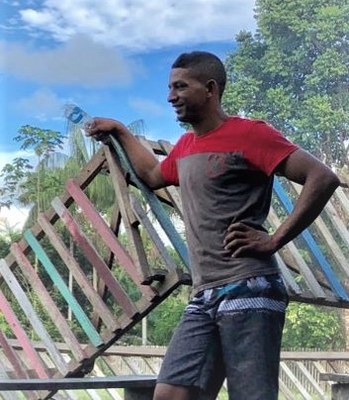From surveillance to preservation: the day-to-day of Amazon monitors
"The importance of monitoring is similar to the act of eating every day to prevent the body from becoming weak. Species conservation is a way of not depriving nature of its power. We have to think about the future and protect it," says Manoel Cordovaldo Chaves, who lives in the São João community at the Itatupã-Baquiá Sustainable Development Reserve (state of Pará).
“Looking after our lakes and rivers – and protecting our land from invasion – is our way to ensure they won't disappear. Intruders catch small and big fish alike, and do not care if there is nothing left for tomorrow. Conservation is our way to ensure we will have fish not only today, but in the future too," says Antônio Marcos Farias, from the Antonina Community in the Baixo Juruá Extractive Reserve (state of Amazonas).
The concerns expressed by Manoel and Antônio resonate with others in the Amazon – people who have also devoted their lives to monitoring fish, turtles, and other species in the region.
Throughout the year, several teams take turns protecting rivers and lakes in protected areas, counting the number of individuals of each species (by collecting data and filling out spreadsheets). In addition, they take part in the release of turtle hatchlings, and engage in monitored fishing to promote biodiversity conservation.
This is the day-to-day of Amazon monitors – who are appointed by their own communities, to act as knowledge multipliers. They encourage the participation of leaders and the whole community in strengthening local organizations and developing projects that generate sustainable income, while protecting the forest and its wealth.
The São João and Antonina communities are part of the Participatory Biodiversity Monitoring (MPB) project, developed by the Ecological Research Institute (IPÊ) in partnership with the Chico Mendes Institute for Biodiversity Conservation (ICMBio) – both of which are implementing partners of the Partnership for the Conservation of Amazon Biodiversity (PCAB). The project is supported by USAID/Brazil and the Gordon and Betty Moore Foundation.
The MPB, which integrates the national Monitora Program, has the goal of supporting biodiversity monitoring and promoting socioenvironmental engagement with a view to strengthen management and conservation efforts in Protected Areas (PAs). In five years, it has directly benefited more than 4,700 people in 17 PAs, helping to protect 12 million hectares in the Amazon.
“I see the community of São Raimundo as a boat. Before (engaging in monitoring projects), local people rowed in all directions, and the boat got nowhere. Today, I see everyone paddling toward the same objective,” says Henrique da Cunha, a monitor who lives on the banks of the Juruá River, in the state of Amazonas.
Henrique says he sees his community “better prepared,stronger, and more focused on biodiversity conservation.” Wild pirarucu, one of the symbols of the Amazon, is one of the target species of monitoring programs in the region. Through sustainable management, riverine communities are preserving the species and generating income for fishing managers and their families.
As a result of participating in the project and involving their communities, monitors now feel more empowered. “I used to be very shy, and didn't understand many things. Now I have learned the value of animals and conservation,” says Raimunda de Jesus Soares, a member of the São Tomé community in the Tapajós-Arapiuns Extractive Reserve.
“I used to see hunting as a means of survival – we hunted for food. Today I know it's not just that. We have to protect the animals, and monitor and keep them in the forest," adds Raimunda, who intends to teach her 18-year-old son Clemerson Soares de Almeida how to become a monitor and continue her work.
Sharing knowledge – MPB manager at IPÊ, Cristina Tofoli believes monitors have a role in disseminating scientific information to traditional communities, in addition, to their importance as biodiversity agents and knowledge multipliers.
“When they help to answer questions such as 'what kind of species will be monitored' or when they collect data, these monitors are doing science,” says Cristina.
In order to further disseminate their knowledge and experiences, the MPB program has developed Knowledge Gatherings. During the gatherings, researchers, monitors, managers, and community leaders have a chance to have a dialogue so that each one, building on their own experiences, may understand biodiversity through science.
“IPÊ and ICMBio have created the 'gatherings' as a way to discuss science and monitoring results. It helps to improve the way in which information is devolved to communities, and to go beyond simply presenting results. This method could be applied to any project that involves obtaining information, and where providing feedback to society is important,” explains Cristina.
Until March last year, gatherings took place in different Protected Areas. However, due to the COVID-19 pandemic, they were suspended, and communication with local communities had to be adapted. Now, some activities take place online.
According to Cristina, with the expected increased number of residents and researchers vaccinated against the new coronavirus, the idea is to try to resume face-to-face Knowledge Gatherings by the end of this year.
Learn more about the Participatory Biodiversity Monitoring project here. A book on the MPB is also available online (July 2019, 2nd edition) here.



